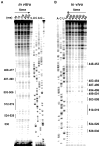Structural analysis of RNA in living cells by in vivo synchrotron X-ray footprinting
- PMID: 20946773
- PMCID: PMC3144761
- DOI: 10.1016/S0076-6879(09)68012-5
Structural analysis of RNA in living cells by in vivo synchrotron X-ray footprinting
Abstract
Chemical footprinting methods are widely used to probe the solution structures of nucleic acids and their complexes. Among the many available modifying reagents, hydroxyl radical is exceptional in its ability to provide nucleotide-level information on the solvent accessibility of the nucleic acid backbone. Until recently, hydroxyl radical footprinting has been limited to in vitro experiments. We describe the use of synchrotron X-radiation to generate hydroxyl radicals within cells for effective footprinting of RNA-protein complexes in vivo. This technique gives results that are consistent with in vitro footprinting experiments, with differences reflecting apparent structural changes to the RNA in vivo.
Copyright © 2009 Elsevier Inc. All rights reserved.
Figures




Similar articles
-
Time-Resolved Hydroxyl Radical Footprinting of RNA with X-Rays.Curr Protoc Nucleic Acid Chem. 2018 Jun;73(1):e52. doi: 10.1002/cpnc.52. Epub 2018 Jun 7. Curr Protoc Nucleic Acid Chem. 2018. PMID: 29927103 Free PMC article.
-
Hydroxyl radical footprinting in vivo: mapping macromolecular structures with synchrotron radiation.Nucleic Acids Res. 2006 May 8;34(8):e64. doi: 10.1093/nar/gkl291. Nucleic Acids Res. 2006. PMID: 16682443 Free PMC article.
-
Following the folding of RNA with time-resolved synchrotron X-ray footprinting.Methods Enzymol. 1998;295:379-402. doi: 10.1016/s0076-6879(98)95050-9. Methods Enzymol. 1998. PMID: 9750229
-
Recent Advances and Applications in Synchrotron X-Ray Protein Footprinting for Protein Structure and Dynamics Elucidation.Protein Pept Lett. 2016;23(3):309-22. doi: 10.2174/0929866523666160201150057. Protein Pept Lett. 2016. PMID: 26833224 Review.
-
Probing the structural dynamics of nucleic acids by quantitative time-resolved and equilibrium hydroxyl radical "footprinting".Curr Opin Struct Biol. 2002 Oct;12(5):648-53. doi: 10.1016/s0959-440x(02)00366-4. Curr Opin Struct Biol. 2002. PMID: 12464318 Review.
Cited by
-
A metastable rRNA junction essential for bacterial 30S biogenesis.Nucleic Acids Res. 2018 Jun 1;46(10):5182-5194. doi: 10.1093/nar/gky120. Nucleic Acids Res. 2018. PMID: 29850893 Free PMC article.
-
Systematic detection of tertiary structural modules in large RNAs and RNP interfaces by Tb-seq.Nat Commun. 2023 Jun 9;14(1):3426. doi: 10.1038/s41467-023-38623-1. Nat Commun. 2023. PMID: 37296103 Free PMC article.
-
Structure and dynamics of protein waters revealed by radiolysis and mass spectrometry.Proc Natl Acad Sci U S A. 2012 Sep 11;109(37):14882-7. doi: 10.1073/pnas.1209060109. Epub 2012 Aug 27. Proc Natl Acad Sci U S A. 2012. PMID: 22927377 Free PMC article.
-
Synchrotron X-ray footprinting on tour.J Synchrotron Radiat. 2014 Jan;21(Pt 1):24-31. doi: 10.1107/S1600577513024715. Epub 2013 Nov 2. J Synchrotron Radiat. 2014. PMID: 24365913 Free PMC article.
-
Progress and challenges for chemical probing of RNA structure inside living cells.Nat Chem Biol. 2015 Dec;11(12):933-41. doi: 10.1038/nchembio.1958. Epub 2015 Nov 17. Nat Chem Biol. 2015. PMID: 26575240 Free PMC article. Review.
References
-
- Balzer M, Wagner R. A chemical modification method for the structural analysis of RNA and RNA-protein complexes within living cells. Anal Biochem. 1998;256(2):240–242. - PubMed
-
- Burkhoff AM, Tullius TD. The unusual conformation adopted by the adenine tracts in kinetoplast DNA. Cell. 1987;48(6):935–943. - PubMed
-
- Cadet J, Bellon S, Douki T, Frelon S, Gasparutto D, Muller E, Pouget JP, Ravanat JL, Romieu A, Sauvaigo S. Radiation-induced DNA damage: formation, measurement, and biochemical features. J Environ Pathol Toxicol Oncol. 2004;23(1):33–43. - PubMed
Publication types
MeSH terms
Substances
Grants and funding
LinkOut - more resources
Full Text Sources
Other Literature Sources
Medical

